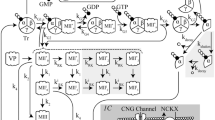Abstract
Phototransduction is a process which links the absorption of photons by a rod or cone to the modulation of voltage across the cell membrane. An important feature of many vertebrate photoreceptors is a mechanism that adjusts the sensitivity and dynamics of the response to light according to the level of illumination.
We construct a system of ordinary differential equations that models what are currently thought to be the important molecule mechanisms involved in phototransduction: this includes consideration of both intracellular enzyme kinetics and the properties of light-insensitive and light-sensitive conductances in the cone membrane. The system contains negative feedback whose functional form is determined by constraining the steady-state behaviour of the system. Despite the highly nonlinear nature of the system of ordinary differential equations, our methods permit us to derive an analytic expression for the first-order frequency response parametric in the steady-state value of only one dynamic variable, the light input. Various unknown kinetic parameters are found by fitting the model to experimental data on the first-order frequency response of cones measured at several mean light levels spanning a range of four log units. Good fits are obtained to the data, and the computed shape of the feedback function agrees qualitatively with recent experiment. Moreover, the model accounts for the dramatic speeding up of the response kinetics and the decrease in response gain with increasing light level.
Similar content being viewed by others
Literature
Altman, J. 1985. “New Visions in Photoreception.”Nature 313, 264–265.
Attwell, D. 1985. “Phototransduction Changes Focus.”Nature 317, 14–15.
—, F. S. Werblin and M. Wilson. 1982. “The Properties of Single Cones Isolated from the Tiger Salamander Retina.”J. Physiol. 328, 259–283.
Baylor, D. A. and M. G. F. Fuortes. 1970. “Electrical Responses of Single Cones in the Retina of the Turtle.”J. Physiol. 207, 77–92.
— and A. L. Hodgkin. 1974. “Changes in Time-Scale and Sensitivity in Turtle Photoreceptors.”J. Physiol. 242, 729–758.
—,— and T. D. Lamb. 1974a. “The Electrical Response of Turtle Cones to Flashes and Steps of Light.”J. Physiol. 242, 685–727.
—,— and —. 1974b. “Reconstruction of the Electrical Responses of Turtle Cones to Flashes and Steps of Light.”J. Physiol. 242, 759–791.
Cobbs, W. H., A. E. Barkdoll III and E. N. Pugh Jr. 1985. “Cyclic GMP Increases Photocurrent and Light Sensitivity of Retinal Cones.”Nature 317, 64–66.
— and E. N. Pugh Jr. 1987. “Kinetics and Components of the Flash Photocurrent of Isolated Retinal Rods of the Larval Salamander,Ambystoma Tigrinum.”J. Physiol. 394, 529–572.
Cote, R. H., M. S. Biernbaum, G. D. Nicol and M. D. Bownds. 1984. “Light-Induced Decreases in cGMP Concentration Precede Changes in Membrane Permeability in Frog Rod Photoreceptors”,J. Biol. Chem. 259, 9635–9641.
Daly, S. J. and R. I. Normann. 1985. “Temporal Information Processing in Cones: Effects of Light Adaptation on Temporal Summation and Modulation.”Vision Res. 25, 1197–1206.
Dawis, S. M., R. M. Graeff, R. A. Heyman, T. F. Walseth and N. B. Goldberg. 1988. “Regulation of Cyclic GMP Metabolism in Toad Photoreceptors.”J. biol. Chem. 263, 8771–8785.
DeVries, G. W., A. I. Cohen, O. Lowry and J. A. Ferendelli. 1979. “Cyclic Nucleotide in the Cone-Dominant Ground-Squirrel Retina.”Expl Eye Res. 29, 315–321.
Haynes, L. and K.-W. Yau. 1985. “Cyclic GMP-Sensitive Conductance in Outer Segment of Catfish Cones.”Nature 317, 61–64.
Heineken, F. G., H. M. Tsuchiya and R. Aris. 1967. “On the Mathematical Status of the Pseudo Steady-State Hypothesis of Biochemical Kinetics.”Math. Biosci. 1, 95–113.
Hodgkin, A. L., P. A. McNaughton and B. J. Nunn. 1987. “Measurement of Sodium-Calcium Exchange in Salamander Rods.”J. Physiol. 391, 347–370.
Jack, J. J. B., D. Noble and R. W. Tsien. 1975.Electric Current Flow in Excitable Cells. Oxford University Press.
Koch, K.-W. and L. Stryer. 1988. “Highly Cooperative Feedback Control of Retinal Rod Guanylate Cyclase by Calcium Ions.”Nature 334, 64–66.
Lamb, T. D. 1986. “Transduction in Vertebrate Photoreceptors: the Roles of Cyclic GMP and Calcium.”Trends Neurosci. 9, 224–228.
Matthews, H. R., R. L. W. Murphy, G. L. Fain and T. D. Lamb. 1988. “Photoreceptor Light Adaptation is mediated by cytoplasmic Calcium Concentration.”Nature 334, 67–69.
Naka, K.-I., M.-O. Itoh and R. L. Chappell. 1987. “Dynamics of Turtle Cones.”J. Gen. Physiol. 89, 321–337.
Nakatani, K. and K.-W. Yau. 1988. “Calcium and Light Adaptation in Retinal Rods and Cones.”Nature 334, 69–71.
Normann, R. A. and I. Perlman. 1979. “The Effects of Background Illumination on the Photoresponses of Red and Green Cones.”J. Physiol. 286, 491–507.
Pugh, E. and J. Altman. 1988. “A Role for Calcium in Adaptation.”Nature 334, 16–17.
Pugh Jr, E. N. and W. H. Cobbs. 1986. “Visual Transduction in Vertebrate Rods and Cones: a Tale of Two Transmitters, Calcium and Cyclic GMP.”Vision Res. 26, 1613–1643.
Schnapf, J. L. and R. N. McBurney. 1980. “Light-Induced Changes in Membrane Current in Cone Outer Segments of Tiger Salamander and Turtle.”Nature 287, 239–241.
Schwartz, E. A. 1985. “Phototransduction in Vertebrate Rods.”Ann. Rev. Neurosci. 8, 339–367.
Shapley, R. M. and C. Enroth-Cugell. 1984. “Visual Adaptation and Retinal Gain Controls.” InProgress in Retinal Research, N. Osborne and G. Chader (eds), pp. 263–346. Oxford: Pergamon Press.
Stryer, L. 1986. “Cyclic GMP Cascade of Vision.”Ann Rev. Neurosci. 9, 87–119.
Tranchina, D., J. Gordon and R. Shapley. 1984. “Retinal Light Adaptation—Evidence for a Feedback Mechanism.”Nature 310, 314–316.
— and C. S. Peskin. 1988. “Light Adaptation in the Turtle Retina: Embedding a Parametric Family of Linear Models in a Single Non-Linear Model.”Visual Neurosci. 1, 339–348.
Yau, K.-W. and K. Nakatani. 1984. “Electrogenic Na−Ca Exchange in Retinal Rod Outer Segment.”Nature 311, 661–663.
— and —. 1985. “Light-Induced Reduction of Cytoplasmic Free Calcium in Retinal Rod Outer Segment.”Nature 313, 579–582.
Author information
Authors and Affiliations
Rights and permissions
About this article
Cite this article
Sneyd, J., Tranchina, D. Phototransduction in cones: An inverse problem in enzyme kinetics. Bltn Mathcal Biology 51, 749–784 (1989). https://doi.org/10.1007/BF02459659
Received:
Issue Date:
DOI: https://doi.org/10.1007/BF02459659




